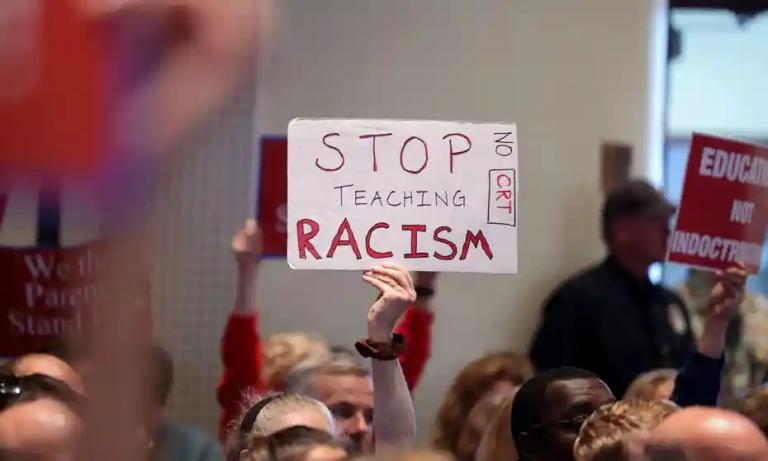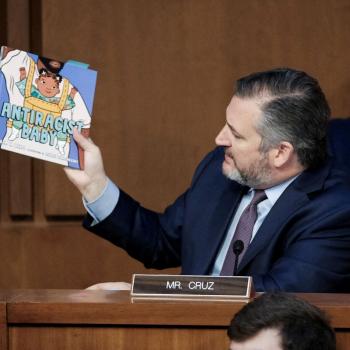
The uproar we are currently experiencing over the topic of the teaching of Critical Race Theory in schools is just the latest in a long history of unwarranted attacks from the far right on public education. It is just the next thing in line where right wing leadership misrepresents the truth and uses mendacious propaganda to play to the deep-seated racial bias and fear of middle class, conservative white America. Let me give you an example of another such false-flag hysteria that swept through America in the not-so-distant past. The Ebonics controversy of the 1990s.
In 1960s the racial achievement gap in education was blamed on the predominant theory of the time, something called the “cultural deficit theory.”
- This theory claimed that inner-city black kids came to school with less capacity to learn language because they were exposed to less words at home because black parents spoke in shorter sentences than white parents so black children were getting less complicated messages.
- Here is a very cring-y Eugenics-like quote from one 1964 study: “The language of culturally deficient children is not an underdeveloped version of English. It is a non-logical mode of expressive behavior. Their communication is primarily through gestures, single words, and a series of badly connected words and phrases, such as, ‘they mine’ or ‘me got juice’.
At the time, no one really seemed to think about holding these standardized tests up to close examine for evidence cultural bias. As it turns out, when they finally did scrutinize them, standardized tests were found to be written and assessed from a completely white, middle-class perspective, which obviously contributed greatly to the racial achievement gap.
Here is a test question example to better illustrate the issue: Students are shown a drawing of a squirrel sitting in a nest in a tree and they are asked, “where is the squirrel?” African American kids tended to answer, “in the tree,” which the test graders marked wrong because they didn’t answer in a complete sentence.
In essence, these tests were very good at identifying which kids were white and middle class, but not a whole lot of good for much else.
The results of such theories led to new (but awful) methods to try to bring black kids up closer to mastery of standard English by punishing them whenever they were caught falling short. This resulted in a drill, drill, drill, and repeat approach to education to fix the problem of these, as one 1968 study labeled them, “linguistically retarded” kids. It also served to stigmatize entire cultures as inferior—a recipe for self-fulfilling prophesy and a vicious cycle of failure.
This went on until some linguists began to reexamine this issue and started questioning whether or not these kids really were somehow linguistically challenged. During this time of inquiry, it became clear that the age of racial segregation, which at that time we were just emerging from, had been so impactful on in black communities that these interactions between black kids and the professional linguists were often the first direct interaction some of the 4 and 5-year-old kids in the study had ever had with a white adult. It became clear that many of the black kids and even their parents, because of the history of how they’d been treated, had come to the idea that they had best not say something wrong in front of white people for fear of repercussions. So, they had become conditioned to speak in very short and halting ways when they were in uncomfortable settings with whites. Once the kids were made comfortable enough to to speak freely without repercussions, they suddenly began speaking in much more complex ways.
In 1972, the noted linguist, Willam Labov, conducted a lengthy study of what he referred to at that time as “Black English.” He spent years visiting the homes of children in Harlem, N.Y. during which time he came to some revealing conclusions. He wrote an article about his findings in The Atlantic in 1972, in which he stated, “the concept of verbal deprivation has no basis in social reality. In fact, black children in urban ghettos receive a great deal of verbal stimulation and participate fully in a highly verbal culture. The myth of verbal deprivation is particularly dangerous because it diverts attention from the real defects of our [student evaluation system] to the imaginary defect of the child.” Mr. Labov went on to compare standardized test answers of white, middle-class students with those of black students and found that in many cases, the white students were scored higher not because of how well they got their point across, but rather by how many poly-syllabic words they used, how long their sentences were, and their use of phrases such as, “I suppose,” or “in conclusion.”
In 1973, a black psychologist named, Robert L. Williams, coined the term “Ebonics,” a combination of the words ebony and phonics, in an effort to take the negative connotation away from the language spoken by many African-Americans and to try to control the narrative on the subject by turning it into something more positive and less degrading. This began a new area of linguistics dedicated to better understanding the patterns and contours of African American speech. Today, the accepted term for this is African American English, rather than Ebonics, but this was the beginning of an effort to use education as a bridge building tool rather than a divisive weapon. And this is what made far-right conservatives so nervous—very similar to the current panic over Critical Race Theory (CRT).
As it turns out, like so many of the challenges we face in this nation, African American English has its roots in slavery. When slaves arrived in America from different parts of Africa, they were often intentionally separated from other slaves who spoke the same languages. This was to prevent them from being able to communicate effectively with one another. Effective communication could lead to organization and revolt. So, by the process of immersion, all the many different cultures from Africa began to meld together and combine with whatever bits of the English language they picked up. Ebonics is a part of the vestigial remains of this sad chapter of the American story. But more than that, to many African Americans it is a vital and precious part of their identity. For decades, this part of black culture was stigmatized.
Identifying African American English as a legitimate thing was a big step. Linguists still debate today whether or not African American English is a separate language or just a different dialect—much like you might find in any number of regions of the country, like Southern Appalachia, New England, Boston, Brooklyn, etc. Regardless of how it’s labeled, the fact that it is recognized as a thing has helped to destigmatize it—except perhaps for those on the far right.
The whole “Ebonics” scare exploded in the 1990s when far-right pundits like Rush Limbaugh started making wild claims about what was going on in some school districts around the country including Los Angeles and Oakland, California. These conservative opportunists never missed an opportunity to stoke the racial fears of their supporters. They began to misrepresent what was actually happening. They claimed that these schools were teaching Ebonics as a separate language, implying that all kids were being forced to use Ebonics in school. When conservative white folks across the nation got wind of this, it started a panic. But none of it was true. What was actually going on in those schools was teaching a deeper understanding of Standard American English by comparing and contrasting it with Ebonics.
Here are just a couple examples of how comparing and contrasting African American English with standard American English can be beneficial to all learners, not just black kids.
- Multiple Negatives
In African American English, the use of multiple negatives strung together in a sentence is commonly used. It isn’t seen as “less-than” standard English. In fact, it’s more closely related to the syntax rules of Spanish. And in some ways, could be seen as a more effective way to convey meaning.
Take these two phrases and compare them…
“He ain’t never got no money.” “He never has any money.”
Obviously, the second version of the sentence would score much higher on any graded essay. For that reason, every student should learn to write it that way. But the first version is much livelier and emotes a great deal more feeling in the message. Perhaps if one were writing a play with dialogue, the first sentence might be superior.
Wouldn’t the discussion of such a topic help any student better understand the nuance of language? This is what was happening in Oakland and L.A.
It scared the hell out of the far right.
- Pluralization
In standard American English we add markers like “s” or “es” to the end of words to show pluralization even when the numeric value is given. In African American English, plural markers are not necessary when a numeric value is already present.
In standard English we would say that we have 47 cents. In African American English, the “s” marker at the end of the word cent is considered redundant because the number 47 already implies plurality.
How much more interesting and valuable would it be if students were asked to compare and contrast and then be able to translate these different things in both directions rather than just one?
This was what was happening in places like Los Angeles and Oakland.
This is what made the far right lose their minds. They did not want to do anything whatsoever that would validate any other form of communication. They preferred instead to stigmatize generation after generation of African American children by portraying their culture as less than.
Remember Robert L. Williams, the black psychologist who coined the term “Ebonics?” Well, here is the rest of the story on him. He went on to develop new standardized tests that were written in a more African American English format and were more culturally aligned to minorities in order to see what impact these tests would have on the racial achievement gap. The results were remarkable. As it turns out, the racial achievement gap remained about the same with one notable exception, this time, it was the white, middle-class students who were on the bottom side of the scale. Remarkable, isn’t it?
Today, American history teachers like me tell the story of America from multiple perspectives. We don’t just force feed the perspective of the dominant white culture. We tell of the struggle of the vanquished people of color—Hispanic Americans, African Americans, Native American Indians, women, immigrants, etc.—and we stir it all together and ask our students to chew on difficult concepts until they’ve formed their own opinions. For too long, America has been taught as a melting pot. That is misleading because the melting pot always seemed to default to the story of the predominant white culture being portrayed as America’s story. In reality, America is not a melting pot. America is a stew. We are made of a multitude of different ingredients and spices that mix together to create something unique.
That should be seen as a good thing.
But it scares the bejezus out of too many white, middle-class Americans.
They call it CRT and they try to make laws to force their preferred idyllic melting pot narrative.
Our kids deserve the truth, not fairytales.















